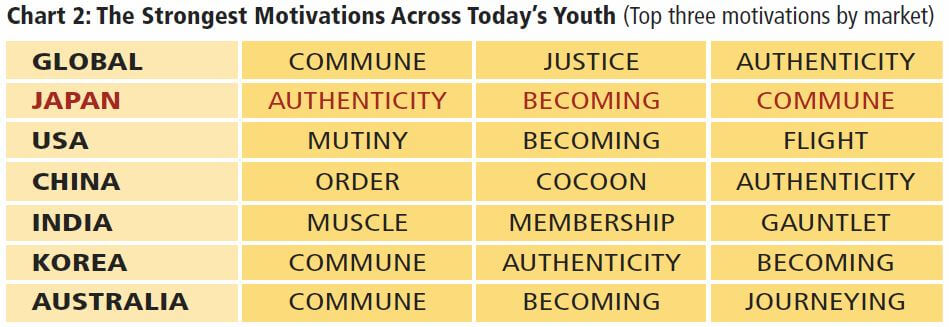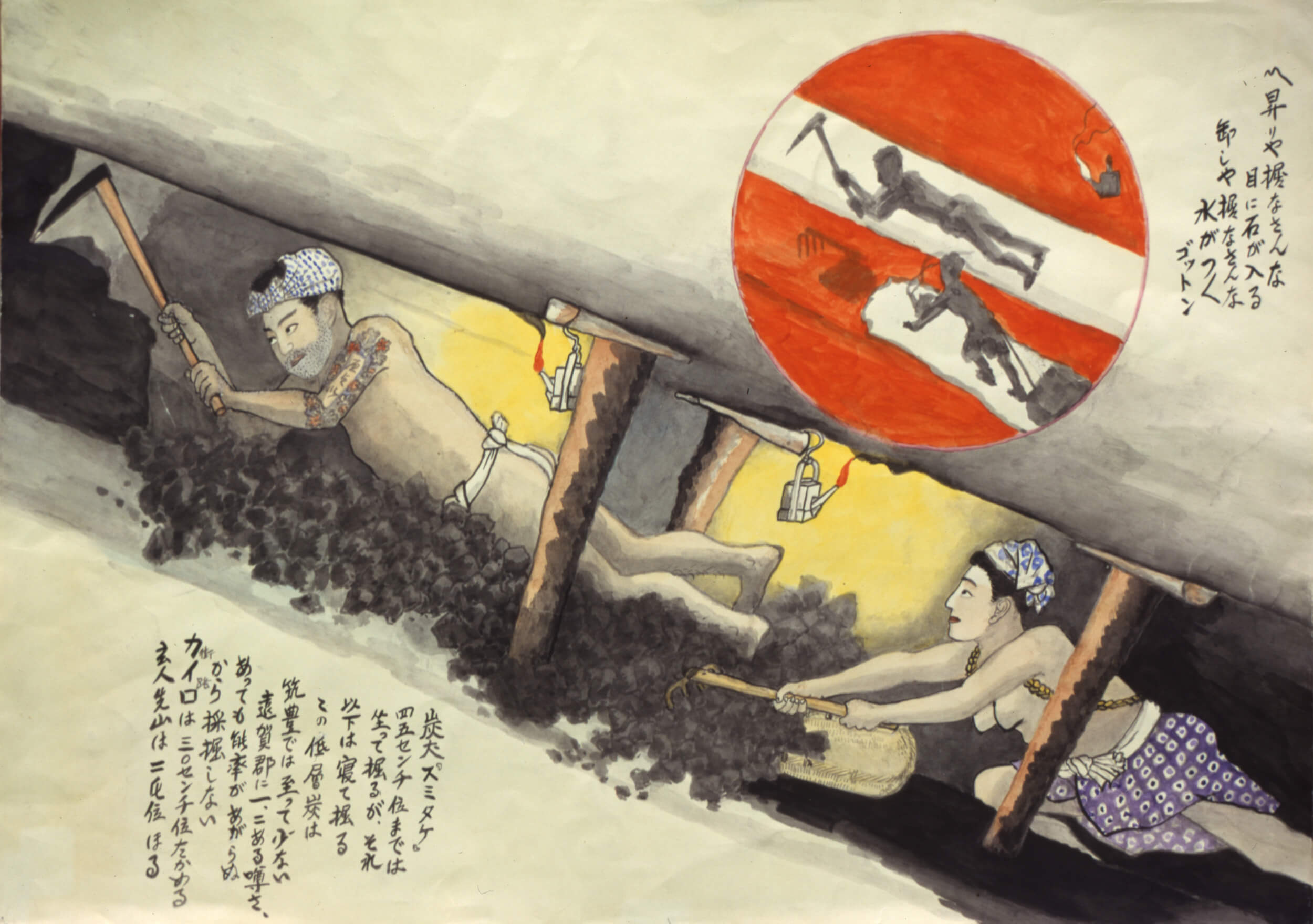Japanese Youth Compared with Youth in Other Countries, the US, India and China
CONTENTS
Recognizing the Facts About the Youth
It’s a question every parent and every marketer ask: “What motivates young people today?”
In Japan there has been a great deal of angst in the last two decades about the growth of “freeters (young part-timers),” of talk of a lost generation of youth, of young people who are no longer interested in building, buying and challenging life.
To help answer these questions, early in 2011 McCann Worldgroup undertook research across 17 countries to understand “the truth about youth.” The study involved reviewing work done with a wide range of marketers, qualitative interviews with youth aged 16-29 in all markets, interviews with key experts and a quantitative survey conducted in seven countries. The focus was the motivations or “whys” behind youth behavior. We identified 16 human motivations ranging from the outer directed (like MUTINY and SURGE) to the more inner directed (like COCOON and BECOMING). See Chart 1 for the full list and definitions. We then established which three motivations were most likely driving behavior across and within markets.
Chart 2 highlights that the three motivations that were most common across all markets are COMMUNE, JUSTICE, and AUTHENTICITY. All of these seem to be driven by the growth and changes in a new social economy powered by the personal technologies that young people everywhere now take for granted. You can see how these trends may have been a major influence in the youth movements in the Middle East in recent months.


Major Motivations in Key Countries
Of course there are also many variations and it is worth thinking about how different young people are in key countries that Japanese companies may be undertaking business:
USA: generally young Americans score low on ORDER and COCOON and highest on MUTINY (the need to rebel and push against the status quo) suggesting that they are not afraid to take risks. They seem more inclined to be individualistic and openly like to believe they do not copy others… “Everyone wants to feel like they matter and are important.”
India: young people in India over index on MUSCLE (the need to exert power or control)… “If I don’t win at everything today, I will be seen as a loser for the rest of my life.” Driven by success and the need to win, they are increasingly wedded to technology (they are the most willing to give up their sense of smell to keep their phone). Versus other countries young Indians are the most likely to want to be remembered as a “powerful person.”
China: of all the markets tested young Chinese are the least interested in “changing the world in a positive way,” possibly because they are currently focused on celebrating and taking advantage of a fast changing China. Unlike youth almost everywhere else, they tend to be driven by the desire COCOON (wanting to achieve safety and security through career and earnings) and ORDER (the need to organize, categorize and rationalize).
We could also see some expected national traits coming through. For example, Australian youth ranked JOURNEYING (the need for exploration and discovery) higher than most which fits with a youth culture that has in recent decades placed a high importance on traveling.
Difference Among the Age Group
There is also an expected split in motivations between younger and older youth. Sixteen-twenty two-year-olds tended to rank MUTINY, MEMBERSHIP and SURGE higher. The tension between MUTINY and MEMBERSHIP highlights the tension of the teen years when there are strong desires to both rebel in some way and at the same time belong to a group. And in order to fit in to new groups there is a certain amount of risk taking (SURGE). Meanwhile the older 22-30 age group over index on JUSTICE, ORDER and CONTACT all of which make sense in a life stage where work is increasingly important and longer term personal relationships are forged or desired. In a separate piece of research McCann has been undertaking since the 3.11 Earthquake we have also noted a much stronger desire among young adults in Japan for further order and contact in their lives. The FUKKATSU research highlights a growing desire among young women for marriage, deep concerns among twenty something men about loneliness and an overall desire for a more stable and orderly life.
Three Important Motivations and Definitions
But in looking at the motivations that ranked as most important for Japanese youth, we saw that they are actually close to their global peers and perhaps that is one of the reasons they are causing such confusion among the older generations. When we look at the three most important motivations, we see a story of a generation that has been offered unending choices throughout their whole lives; they were the first generation in the world to have constant mobile access to the internet; they were educated in an education system that changed in the 1980’s to one that is more personality and individuality driven and have grown up at a time when the struggling economy has forced changed expectations of careers, the future and relationships. No wonder that the motivations that matter are ones that encourage creating deeply personalized worlds:
- AUTHENTICITY: which for Japanese youth is about the desire to “have my core and establish my style.” Since they are always online, they are exposed to huge amounts of information and options and as a result they value seeing things “as they are” and then selecting to match and enhance their personal brand.
- BECOMING: these newer generations of Japanese are more likely to believe that they have, or should have a chance to personally make their own way. There is a great desire for personal development and far less desire to “do what is just normal.” Hence the growth of a “freeter mentality,” which at the very least encourages developing a unique perspective on one’s self and the future.
- COMMMUNE: this generation is the most connected in history and at the same time maintains multiple connections. They have become very strategic in their decision making about communicating with their various groups of friends, always judging and modifying their behavior and messaging to use their communities to greatest advantage.
The motivation for ORDER was, with the exception of China, among the lowest ranked everywhere including Japan. This is not because young Japanese are by nature messy, although mothers might disagree. It simply goes against everything that they see in pop culture today. It has in the last decade penetrated every aspect of youth culture from music to fashion to self identity. In Japan we have found that young people do much more to identify themselves as having a number of “faces” rather than a single identity. At the same time within each of their varied groups of friends they will want to maximize their contribution and distinctiveness with their own funk and swagger. Each member of a group having their own style creates a greater group aura and vibe. A habit that obviously has been picked up from their favorite music groups where each member brings a unique style while combining to bring a higher level of harmony.
Young Japan is now a generation of neo-otaku, specialists who are using their distinct interests to build a role for themselves in multiple worlds of connections. And this really matters … because marketing to today’s youth is about helping them build their own brand value and specialization.


